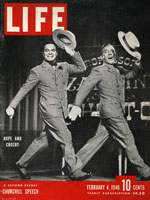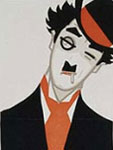Tom Mix Museum [OK]
The Museum houses items from actor Tom Mix's personal collection, providing a glimpse into the life of one of Oklahoma's famous figures.
The museum offers exhibits.
The Museum houses items from actor Tom Mix's personal collection, providing a glimpse into the life of one of Oklahoma's famous figures.
The museum offers exhibits.

This collection presents 1,395 photographs by the American photographer, music and dance critic, and novelist Carl Van Vechten (1880-1964). The site consists primarily of studio portraits of celebrities, most of whom were involved in the arts, including actors, such as Marlon Brando and Paul Robeson; artists, such as Marc Chagall and Frida Kahlo; novelists, such as Theodore Dreiser and Willa Cather; singers, such as Ethel Waters and Billie Holiday; publishers, such as Alfred A. Knopf and Bennett Cerf; cultural critics, such as H. L. Mencken and Gilbert Seldes; and figures from the Harlem Renaissance, such as Langston Hughes, Countee Cullen, and Zora Neale Hurston.
More than 80 photographs capture Massachusetts and Maine landscapes and seascapes; others include eastern locations and New Mexico. Many photographs of actors present them in character roles. Searchable by keyword and arranged into subject and occupational indexes, this collection also includes a nine-title bibliography and background essay of 800 words on Van Vechten's life and work. A valuable collection for the documentation of the mid-20th-century art scene.

This tribute to Bob Hope examines his contributions to American culture and entertainment. The site includes a short (1,000 words with 150 photographs) history of vaudeville in the United States and four essays (1,000 words each) examining vaudeville's legacy. There is a 3,000-word biography of Hope, covering most of his 70-year career, and sections that deal with each of his many careers specifically. His early radio work, his long movie career, and his many television appearances are all documented.
Of particular interest are the 26 Bob Hope caricatures in photograph, cartoon, and sculpture. The Joke File includes six pages (out of a massive collection that exceeds 85,000 pages) of Hope's seasonal material. On the Road: USO Shows documents Hope's commitment to America's armed forces by highlighting his many trips overseas to entertain American troops. Although the essays are useful in explaining the relationship of vaudeville to American culture, the strength of the site is its approximately 250 primary sources (mostly photographs and documents).

A selection of more than 16,000 items relating to the performing arts of the late 19th and early 20th centuries is offered on this website. Materials include books, clippings, photographs, drawings, music, manuscripts, moving images, posters and lobby cards, programs, and recorded sound.
Diverse types of material on specific performers—such as Ruth St. Denis, Loie Fuller, and Isadora Duncan—have been selected to allow focused study. More than 2,400 entries are available for photographs (entries often contain multiple images) as well as 21 large format clippings scrapbooks, each with more than 100 pages. The website also presents 16 full-text books and video clips from nine early motion pictures, including a nine-minute clip featuring renowned dancer Anna Pavlowa in Lois Weber's The Dumb Girl of Portici (1914).
The Birthplace of John Wayne preserves the home in which actor John Wayne (1907-1979) was born in 1907. The site has been restored to a 1907 appearance; and collections include movie props, personal letters, and photographs.
The birthplace offers exhibits and guided tours.
In the early 1930s, Will Rogers was the most popular and highest paid actor in Hollywood. From his start in vaudeville theater with a trick roping act, he rose to worldwide fame as a columnist, philosopher, radio personality, and movie star. During the 1920s, he bought land in Santa Monica, where he developed a ranch. Eventually, the Rogers's owned 186 acres overlooking the Pacific Ocean, in what is now known as Pacific Palisades. The ranch became the place where Will Rogers could relax with his family and friends, pursuing his favorite pastimes of riding and roping. At his untimely death in a plane crash in 1935, Will Rogers's ranch consisted of a 31-room ranch house, a stable, corrals, riding ring, roping arena, polo field, golf course, and hiking trails. When his widow, Betty, died in 1944, the ranch became a state park.
The park offers exhibits, tours, educational programs, and educational and recreational events.
Kitty Wilson Evans, an award-winning costumed interpreter at Historic Brattonsville, explains how slave children worked on the plantation.
Appears to no longer be available.

Ballyhoo! presents a concise history of advertising posters and their use of celebrity in the United States, as well as the export of U.S. celebrity to other countries. The website was initially created as an accompaniment to a National Portrait Gallery exhibit which ran in 2008 through 2009.
The site is broken down into an introduction and eight short explanatory sections, each with a two-paragraph essay and four to eight related posters to view.